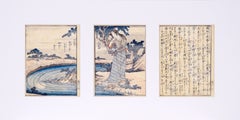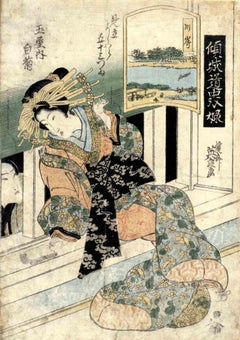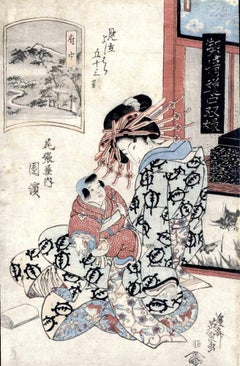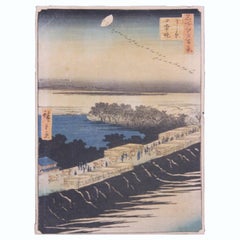Keisei Eisen Art
Japanese, 1790-1848
Keisai Eisen was a Japanese ukiyo-e artist who specialized in bijin-ga. His best works, including his ōkubi-e, are considered to be masterpieces of the "decadent" Bunsei Era (1818–30). Eisen was also known as Ikeda Eisen and wrote under the name of Ippitsuan.
to
4
4
6
2
6
1
1
Overall Height
to
Overall Width
to
4
8
7
5
3
3
3
3
3
2
2
1
1
1
1
1
8
8
6,958
3,331
2,514
1,213
8
4
2
1
1
Artist: Keisei Eisen
Mitate of a Daimyo's Procession Crossing Ryogoku Bridge - Woodblock Print
By Keisai Eisen
Located in Soquel, CA
Mitate of a Daimyo's Procession Crossing Ryogoku Bridge - Woodblock Print
Woodblock print of a procession by Keisai Eisen (Japanese, 1790–1848). Terrific triptych of a procession of...
Category
Early 19th Century Edo Keisei Eisen Art
Materials
Woodcut, Rice Paper, Ink
3 Panel Hand Colored Japanese Woodcut Print Lithograph
By Keisai Eisen
Located in Soquel, CA
3 Panel Hand Colored Japanese Woodcut Print Lithograph
Three panel hand colored woodcut lithograph from Nanso Satomi hakkenden, Tale of the Eight Dogs...
Category
Early 19th Century Edo Keisei Eisen Art
Materials
Paper, Ink, Woodcut
Courtesan - Woodcut by Keisai Eisen - 1830
By Keisai Eisen
Located in Roma, IT
Courtesan is an original modern artwork realized by Keisai Eisen in the first half of the 19th Century.
Signed and inscribed on plate.
Total dimension...
Category
1830s Modern Keisei Eisen Art
Materials
Paper, Woodcut
The High - Ranking Courtesan - Woodcut Print by Keisai Eisen - 1820s
By Keisai Eisen
Located in Roma, IT
The high-ranking courtesan Shiragiku Bijinga is an original modern artwork realized by Keisai Eisen in the 1821-23.
Woodcut Print Oban Format.
From the ...
Category
19th Century Modern Keisei Eisen Art
Materials
Woodcut
Little Spring Horse - Woodcut Print by Keisai Eisen - 1830s
By Keisai Eisen
Located in Roma, IT
Little Spring Horse is an original modern artwork realized by Keisai Eisen in 1820-30.
Woodcut Print Oban Format From the series "Osana asobi" (Children'...
Category
19th Century Modern Keisei Eisen Art
Materials
Woodcut
Bijinga - Woodcut by Keisai Eisen - 1830
By Keisai Eisen
Located in Roma, IT
Bijinga is an original modern artwork realized by Keisai Eisen in the 1830s.
Oban from the series "Keisei dochu Sugoroku, mitate Tokaido gojusan stugi" (...
Category
1830s Modern Keisei Eisen Art
Materials
Paper, Woodcut
Biensennyo-ko Japanese Woodblock Print
By Keisai Eisen
Located in Houston, TX
Japanese Woodblock print of a Biensennyo-ko a powder face women. Behind the women is a framed cityscape. The print is possibly from the series "Eight Favorite Things in the Modern World". The woodblock print is printed on rice paper. The print is not framed.
Artist Biography: Keisai Eisen...
Category
Early 1800s Edo Keisei Eisen Art
Materials
Woodcut
Tamaya Nishi, Hana-murasaki (Purple Flower)
By Keisai Eisen
Located in Fairlawn, OH
Signed: Keisai Eisen ga;
Seal: Kiwame
Series: Contemporary Scenes in the Pleasure Quarters
Publisher: Wakasaya Yoichi
Note: This is a famous ...
Category
Early 19th Century Keisei Eisen Art
Materials
Woodcut
Related Items
Nihon Embankment in Yoshiwara Japanese Woodblock Print
By Utagawa Hiroshige (Ando Hiroshige)
Located in Houston, TX
Woodblock print from the Edo period. The print was apart of a series that Hiroshige did titled, "One Hundred Famous Views of Edo". The woodblock print is printed on rice paper.
The p...
Category
1850s Edo Keisei Eisen Art
Materials
Woodcut
H 13.75 in W 9.5 in D 0.004 in
"Maiko Kyoto" Japanese Figurative Woodblock Print
By Kiyoshi Saitō
Located in Houston, TX
Kiyoshi Saitō (1907 – 1997) Maiko Kyoto (B) 1959, portrait of a girl facing left, with black and white obi; strong woodgrain texture background. Signature and artist’s seal lower left. Margins are covered with mat board possibly concealing title, date and edition. Visible Area: H 20.75 in. x W 15 in.
Artist Biography:
Kiyoshi Saito was born in Fukushima prefecture in 1907. At the age of five he moved to Otaru in Hokkaido, where he would come to serve as an apprentice to a sign painter. Saito became infatuated with art after studying drawing with Gyokusen Narita and moved to Tokyo in 1932 to study Western-style painting at the Hongo Painting Institute. He began experimenting with woodblock prints and exhibiting his works with Nihon Hanga Kyokai in 1936. Saito mainly worked in oil painting until his invitation from Tadashige Ono...
Category
20th Century Modern Keisei Eisen Art
Materials
Woodcut
Don't Try So Hard, limited edition, silkscreen, Pop Art, Green Eyes, unframed
By Mitch McGee
Located in Riverdale, NY
Mitch McGee, Don't Try So Hard, Limited Edition Pop Art Print, Silkscreen, Edition of 40. Image is 20" round, paper size 24x24. Each signed and numbered. It is unframed.
The influences for McGee's own artwork came from the style of Pop Art legend, Roy Lichtenstein. According to McGee, "Lichtenstein with a Red Bow was the first piece that started me down this rabbit hole. Roy Lichtenstein took comic strips and repositioned them as lithography. In an almost tongue-in-cheek fashion I wondered how I could take one of his pieces and recreate it in another medium. The easy answer for me was wood. I grew up working with it and, combined with my graphic design background, it left me with a new medium and expression that I think really works." From that start, Houston artist, McGee began to create his own style and establish his unique voice.
Today, his creativity exists in that space between painting and sculpture. In his Birch series, McGee uses pieces of wood, each illustrated, hand cut and stained or painted to create dimensional pieces. Each painting is filled with thick layers and subtle shadows. There is a warmth created by the imperfection of the birch and its grain that creates an emotional connection. Each painting is a labor of love, taking 40 to 50 hours or more to complete.
McGee has created original works inspired by Superhero comics, Sports icons, as well as romantic moments using thick lines and bold colors to bring these scenes to life in his own way. Each artwork is filled with humor, irony, compassion or seduction.
His artwork has been exhibited throughout Texas since 2001 and in New York with Elisa Contemporary Art...
Category
2010s Pop Art Keisei Eisen Art
Materials
Woodcut, Archival Paper
H 24 in W 24 in D 0.25 in
HELL CANTO 19
By Salvador Dalí
Located in Aventura, FL
Woodblock engraving on paper from the Divine Comedy series. Sheet size 13 x 10 inches. Frame size approx 18 x 15 inches. Edition 4,765 in French, 3,000 in Italian, 300 in German.
...
Category
1960s Surrealist Keisei Eisen Art
Materials
Woodcut, Paper
Toilet
By Eric Gill
Located in Storrs, CT
Toilet. (After a drawing by Norval Gray.) 1923. Wood engraving on sycamore, end grain. Physick 256. 4 1/2 x 2 1/2 (sheet 5 5/8 x 4 1/8). Proof printed on sturdy Japanese mulberry lai...
Category
Early 20th Century Modern Keisei Eisen Art
Materials
Woodcut, Engraving
'Madman's Drum (Plate 41)' — 1930s Graphic Modernism
By Lynd Ward
Located in Myrtle Beach, SC
Lynd Ward, 'Madman's Drum, Plate 41', wood engraving, 1930, edition small. Signed in pencil. A fine, black impression, on off-white tissue-thin Japan paper; the full sheet with margins (1 5/8 to 2 1/2 inches); a small paper blemish in the upper right margin, away from the image, otherwise in excellent condition. Scarce. Matted to museum standards, unframed.
Image size 5 1/2 x 3 3/4 inches (140 x 95 mm); sheet size 9 5/8 x 7 1/8 inches (244 x 181 mm).
From Lynd Ward’s book of illustrations without words, 'Madman’s Drum', Jonathan Cape and Harrison Smith, New York, 1930. Illustrated in 'Storyteller Without Words: The Wood Engravings of Lynd Ward', Harry Abrams, New York, 1974.
Reproduced in 'Storyteller Without Words, the Wood Engravings of Lynd Ward', Harry N. Abrams, New York, 1974.
ABOUT THE ARTIST
Lynd Ward is acknowledged as one of America’s foremost wood engravers and book illustrators of the first half of the twentieth century. His innovative use of narrative printmaking as a stand-alone storytelling vehicle was uniquely successful in reaching a broad audience. The powerful psychological intensity of his work, celebrated for its dynamic design, technical precision, and compelling dramatic content, finds resonance in the literature of Poe, Melville, and Hawthorne. Like these classic American writers, Ward was concerned with the themes of man’s inner struggles and the role of the subconscious in determining his destiny. An artist of social conscience during the Great Depression and World War II, he infused his graphic images with his unique brand of social realism, deftly portraying the problems that challenged the ideals of American society.
The son of a Methodist preacher, Lynd Ward, moved from Chicago to Massachusetts at an early age. He graduated from the Teachers College of Columbia University, New York, in 1926, where he studied illustration and graphic arts. He married May Yonge McNeer in 1936 and left for Europe for their honeymoon in Eastern Europe. After four months, they settled in Leipzig, where Ward studied at the National Academy of Graphic Arts and Bookmaking. Inspired by Belgian expressionist artist Frans Masereel's graphic novel ‘The Sun,’ and another graphic novel by the German artist Otto Nückel, ‘Destiny,’ he determined to create his own "wordless" novel. Upon his return to America, Ward completed his first book, ‘God's Man: A Novel in Woodcuts,’ published in 1929. ‘Gods’ Man’ was a great success for its author and publisher and was reprinted four times in 1930, including a British edition. This book and several which followed it, ‘Madman’s Drum,’ 1930, ‘Wild Pilgrimage...
Category
1930s American Modern Keisei Eisen Art
Materials
Woodcut
Don't Try So Hard, limited edition, silkscreen, Pop Art, Green Eyes, Framed
By Mitch McGee
Located in Riverdale, NY
Mitch McGee, Don't Try So Hard, Limited Edition Pop Art Print, Silkscreen, Edition of 40. Image is 20" round, paper size 24x24. Each signed and numbered. It is currently framed to 25x25.
The influences for McGee's own artwork came from the style of Pop Art legend, Roy Lichtenstein. According to McGee, "Lichtenstein with a Red Bow was the first piece that started me down this rabbit hole. Roy Lichtenstein took comic strips and repositioned them as lithography. In an almost tongue-in-cheek fashion I wondered how I could take one of his pieces and recreate it in another medium. The easy answer for me was wood. I grew up working with it and, combined with my graphic design background, it left me with a new medium and expression that I think really works." From that start, Houston artist, McGee began to create his own style and establish his unique voice.
Today, his creativity exists in that space between painting and sculpture. In his Birch series, McGee uses pieces of wood, each illustrated, hand cut and stained or painted to create dimensional pieces. Each painting is filled with thick layers and subtle shadows. There is a warmth created by the imperfection of the birch and its grain that creates an emotional connection. Each painting is a labor of love, taking 40 to 50 hours or more to complete.
McGee has created original works inspired by Superhero comics, Sports icons, as well as romantic moments using thick lines and bold colors to bring these scenes to life in his own way. Each artwork is filled with humor, irony, compassion or seduction.
His artwork has been exhibited throughout Texas since 2001 and in New York with Elisa Contemporary Art...
Category
2010s Pop Art Keisei Eisen Art
Materials
Woodcut, Archival Paper
H 25 in W 25 in D 1.5 in
Edo Landscape Japanese Woodblock Print
By Utagawa Hiroshige (Ando Hiroshige)
Located in Houston, TX
Edo Meisho woodblock print of a famous Japanese coastal dock. This woodblock is most likely apart of the series "One Hundred Famous Views of Edo." The woodblock print is printed on r...
Category
1850s Edo Keisei Eisen Art
Materials
Woodcut
H 10 in W 15 in D 0.004 in
'Simplicius' Farewell to the World' — Graphic Modernism
By Fritz Eichenberg
Located in Myrtle Beach, SC
Fritz Eichenberg, 'Simplicius’ Farewell To The World' from the suite 'The Adventurous Simplicissimus', wood engraving, 1977, artist's proof apart from the edition of 50. Signed in pencil. Signed in the block, lower right. A fine, richly-inked impression, on cream wove paper, with full margins (1 1/2 to 2 inches), in excellent condition. Image size 14 x 12 inches (356 x 305 mm); sheet size 17 1/2 x 15 inches (445 x 381 mm). Archivally sleeved, unmatted.
ABOUT THIS WORK
'Simplicius Simplicissimus' (German: Der abenteuerliche Simplicissimus Teutsch) is a picaresque novel of the lower Baroque style, written in five books by Hans Jakob Christoffel von Grimmelshausen published in 1668, with the sequel Continuatio appearing in 1669.
The novel is told from the perspective of its protagonist Simplicius, a rogue or picaro typical of the picaresque novel, as he traverses the tumultuous world of the Holy Roman Empire during the Thirty Years' War. Raised by a peasant family, he is separated from his home by foraging dragoons. He is adopted by a hermit living in the forest, who teaches him to read and introduces him to religion. The hermit also gives Simplicius his name because he is so simple that he does not know his own name. After the death of the hermit, Simplicius must fend for himself. He is conscripted at a young age into service and, from there, embarks on years of foraging, military triumph, wealth, prostitution, disease, bourgeois domestic life, and travels to Russia, France, and an alternate world inhabited by mermen. The novel ends with Simplicius turning to a life of hermitage, denouncing the world as corrupt.
ABOUT THE ARTIST
Fritz Eichenberg (1901–1990) was a German-American illustrator and arts educator who worked primarily in wood engraving. His best-known works were concerned with religion, social justice, and nonviolence.
Eichenberg was born to a Jewish family in Cologne, Germany, where the destruction of World War I helped to shape his anti-war sentiments. He worked as a printer's apprentice and studied at the Municipal School of Applied Arts in Cologne and the Academy of Graphic Arts in Leipzig, where he studied under Hugo Steiner-Prag. In 1923 he moved to Berlin to begin his career as an artist, producing illustrations for books and newspapers. In his newspaper and magazine work, Eichenberg was politically outspoken and sometimes wrote and illustrated his reporting.
In 1933, the rise of Adolf Hitler drove Eichenberg, who was a public critic of the Nazis, to emigrate with his wife and children to the United States. He settled in New York City, where he lived most of his life. He worked in the WPA Federal Arts Project and was a member of the Society of American Graphic Artists.
In his prolific career as a book illustrator, Eichenberg portrayed many forms of literature but specialized in works with elements of extreme spiritual and emotional conflict, fantasy, or social satire. Over his long career, Eichenberg was commissioned to illustrate more than 100 classics by publishers in the United States and abroad, including works by renowned authors Dostoyevsky, Tolstoy, Charlotte and Emily Brontë, Poe, Swift, and Grimmelshausen. He also wrote and illustrated books of folklore and children's stories.
Eichenberg was a long-time contributor to the progressive magazine The Nation, his illustrations appearing between 1930 and 1980. Eichenberg’s work has been featured by such esteemed publishers as The Heritage Club, Random House, Book of the Month Club, The Limited Editions Club, Kingsport Press, Aquarius Press, and Doubleday.
Raised in a non-religious family, Eichenberg had been attracted to Taoism as a child. Following his wife's unexpected death in 1937, he turned briefly to Zen Buddhist meditation, then joined the Religious Society of Friends in 1940. Though he remained a Quaker until his death, Eichenberg was also associated with Catholic charity work through his friendship with Dorothy Day...
Category
1970s American Modern Keisei Eisen Art
Materials
Woodcut
Amsterdam - Woodcut Print by Frans Masereel - 1933
By Frans Masereel
Located in Roma, IT
Amsterdam is an artwork realized by Frans Masereel, 1933.
Woodcut print representing Amsterdam.
75 x 55 with frame; 17h x 12 cm each work.
Good conditions.
Category
Early 20th Century Modern Keisei Eisen Art
Materials
Woodcut, Paper
No Reserve
H 29.53 in W 21.66 in D 0.4 in
'The Pimp' — Graphic Modernism
By Fritz Eichenberg
Located in Myrtle Beach, SC
Fritz Eichenberg, 'The Pimp', wood engraving, 1980, artist's proof before the edition. Signed in pencil. Signed in the block, lower right. A fine, richly-inked impression, on cream wove paper, with full margins (2 3/16 to 3 1/2 inches), in excellent condition. Archivally sleeved, unmatted.
Image size 12 x 9 3/4 inches (305 x 248 mm); sheet size 18 x 14 inches (457 x 356 mm).
ABOUT THE ARTIST
Fritz Eichenberg (1901–1990) was a German-American illustrator and arts educator who worked primarily in wood engraving. His best-known works were concerned with religion, social justice, and nonviolence.
Eichenberg was born to a Jewish family in Cologne, Germany, where the destruction of World War I helped to shape his anti-war sentiments. He worked as a printer's apprentice and studied at the Municipal School of Applied Arts in Cologne and the Academy of Graphic Arts in Leipzig, where he studied under Hugo Steiner-Prag. In 1923 he moved to Berlin to begin his career as an artist, producing illustrations for books and newspapers. In his newspaper and magazine work, Eichenberg was politically outspoken and sometimes wrote and illustrated his reporting.
In 1933, the rise of Adolf Hitler drove Eichenberg, who was a public critic of the Nazis, to emigrate with his wife and children to the United States. He settled in New York City, where he lived most of his life. He worked in the WPA Federal Arts Project and was a member of the Society of American Graphic Artists.
In his prolific career as a book illustrator, Eichenberg portrayed many forms of literature but specialized in works with elements of extreme spiritual and emotional conflict, fantasy, or social satire. Over his long career, Eichenberg was commissioned to illustrate more than 100 classics by publishers in the United States and abroad, including works by renowned authors Dostoyevsky, Tolstoy, Charlotte and Emily Brontë, Poe, Swift, and Grimmelshausen. He also wrote and illustrated books of folklore and children's stories.
Eichenberg was a long-time contributor to the progressive magazine The Nation, his illustrations appearing between 1930 and 1980. Eichenberg’s work has been featured by such esteemed publishers as The Heritage Club, Random House, Book of the Month Club, The Limited Editions Club, Kingsport Press, Aquarius Press, and Doubleday.
Raised in a non-religious family, Eichenberg had been attracted to Taoism as a child. Following his wife's unexpected death in 1937, he turned briefly to Zen Buddhist meditation, then joined the Religious Society of Friends in 1940. Though he remained a Quaker until his death, Eichenberg was also associated with Catholic charity work through his friendship with Dorothy Day...
Category
1980s American Modern Keisei Eisen Art
Materials
Woodcut
A Woodcut on Paper, Self-Portrait of Emil Armin
By Emil Armin
Located in Chicago, IL
A woodcut on paper of a self-portrait of artist Emil Armin.
Emil Armin was born in Radautz, Austria in 1883. By the age of 10, Armin was orphaned and was raised by his older siblings. He supported himself by working in restaurants and drew in his spare time. In 1905, at the age of 21, Armin immigrated to Chicago. He began studying at the Art Institute of Chicago in 1907, but financial difficulties forced him to start and stop a number of times, finally graduating in 1920. He studied with George Bellows and Randall Davey. Armin was an integral part of Chicago’s 57th Street Art Colony and exhibited in both the more avant-garde Chicago No-Jury Society Shows, as well as the more formal and conventional Chicago Society of Artists Exhibitions, the Chicago Renaissance Society and Art Institute of Chicago (1922-1949) exhibitions. He taught at Hull House...
Category
1920s American Modern Keisei Eisen Art
Materials
Paper, Woodcut
Keisei Eisen art for sale on 1stDibs.
Find a wide variety of authentic Keisei Eisen art available for sale on 1stDibs. You can also browse by medium to find art by Keisei Eisen in woodcut print, paper and more. Much of the original work by this artist or collective was created during the 19th century and is mostly associated with the modern style. Not every interior allows for large Keisei Eisen art, so small editions measuring 8 inches across are available. Customers who are interested in this artist might also find the work of Utagawa Yoshitora, Kaoru Kawano, and Utagawa Kunisada III. Keisei Eisen art prices can differ depending upon medium, time period and other attributes. On 1stDibs, the price for these items starts at $485 and tops out at $1,800, while the average work can sell for $801.





